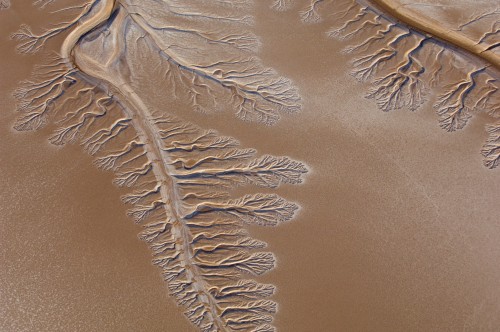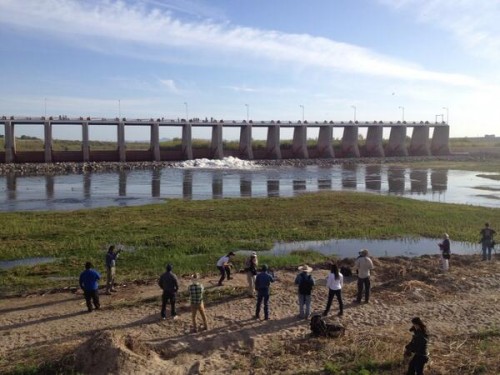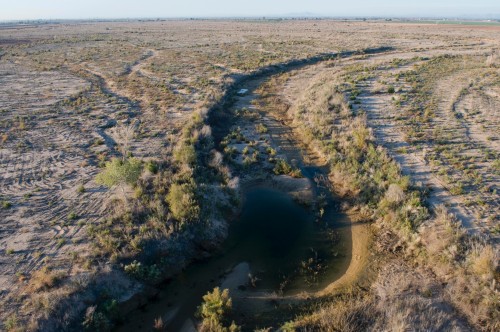Until last Sunday, the Colorado River ended in Yuma, Arizona, backed up against an unremarkable span of concrete called the Morelos Dam on the Mexican border. Every drop of water above the dam was already spoken for -– supplying water to Los Angeles, Las Vegas, Phoenix and Denver as well as irrigating farm fields in both the U.S. and Mexico. Barely a trickle of the river that had carved the Grand Canyon continued past the dam. And all of that was headed toward Mexicali farmland, not the last seventy miles to the Gulf of California.

But, on March 23rd, the gates of the Morelos Dam lifted, sending a pulse of water downstream that will mimic the increased flow that used to be provided by spring rains and Rocky Mountain snowmelt. After the pulse, the gates will remain open for roughly two months, giving the lower Colorado enough flow to, perhaps, complete its run to the Sea of Cortez.
The flood is timed to coincide with the yearly release of seeds from the few remaining cottonwoods and willows that line the historic riverbed of the Colorado River. The initial pulse will disperse seeds downstream, and the steady flow that follows will nurture young seedlings, hopefully buying them time to get roots down far enough to a source of groundwater that will carry them through the next dry spell.

Stationed at points downstream, members of a bi-national team of scientists, agencies and NGOs will be monitoring the flood, checking on seed germination, shifting sandbars, and taking note of any migrating waterfowl that stop over in the suddenly reborn wetland. A few wetter than average springs in the 1990s ended up pushing reservoirs on the Colorado beyond capacity and sending water downstream in a few different pulses. Conservationists and researchers were encouraged by the quick response of the ecosystem to those events and used them as an example to foster hope for the current flood.
While the story is undoubtedly a great success in terms of international collaboration and getting environmental concerns to the water allocation table, it begs the question, “Then what?” After the initial jolt of life to what used to be two million acres of wetland smack dab in the middle of the desert, where is the next flood coming from?
The current 105,000 acre feet of water is the result of a water surplus purchase by the Colorado River Delta Water Trust, a group of various non-profit organizations wanting to ensure that some of the Colorado River is set aside for ecological, not economic purposes. But they are quick to point out that the water now flowing through the dam is not a solution. Funds to keep purchasing future surpluses or a binding agreement for continual flow into the river are needed to ensure the system really returns.

Whatever happens, says Jim Kitchell, an emeritus professor of zoology at the University of Wisconsin-Madison, “don’t expect a lot soon.” Kitchell served as a member of the U.S. Geological Survey’s Grand Canyon Monitoring and Research Center earlier in his career and was involved in experimental flooding projects on those reaches of the Colorado as well as parts of the Rio Grande. Results from those studies were mixed, mostly, he says, because “it takes a long time to grow a tree. [The] most important part is commitment to continuing the process until it is self sustaining. That applies to the ecosystem and the process that makes water available.” And, he notes, “if you’re buying the water from farmers … don’t be surprised if the political winds shift.”
Still, even if the Colorado River delta never receives another drop, on March 23rd, the Morelos Dam opened its gates and one hell of a real-world, landscape-scale experiment rushed downstream.
**
Image Credits: Pete McBride, USGS and John Fleck via Twitter, @jfleck
I’ve just returned from Morelos Dam and the delta. Nice summary of an amazing ecological and political experiment. Just to be a pedant, the current 105,000 acre foot pulse release is the US & Mexican government contribution. The NGO money will go toward a future release called the base flow, about half that size, meant to nurture the new seedlings beyond May.
For more I recommend journalist and water nerd John Fleck of Albuquerque, inkstain.net/jfleck.
Make that inkstain.net/fleck.